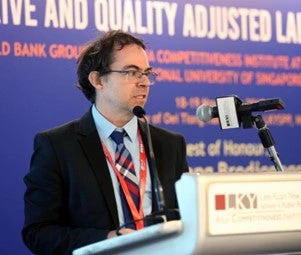 Currently, only 2 percent of households in the core of Jakarta, which has a population of 10 million, are connected to the public sewerage system
Currently, only 2 percent of households in the core of Jakarta, which has a population of 10 million, are connected to the public sewerage system
Indonesia, the world’s fourth most populous country, is becoming increasingly urban. Today over half of the population lives in cities; by 2045, the centenary of Indonesia’s independence, nearly three-quarters will.
While urbanization has helped to deliver prosperity to Indonesia, it has not done so to the same extent as in many of its neighboring countries . According to the recently launched report, Time to ACT: Realizing Indonesia’s Urban Potential, urbanization’s promise to deliver prosperity requires reforms to better manage negative congestion forces that afflict Indonesia’s cities . These forces arise from rising urban population pressures on basic services, infrastructure, land, housing markets, and the environment. They undermine the livability of cities and dampen the prosperity gains from urbanization.
Out of the negative congestion forces that Indonesian cities are grappling with, one of the most serious is the lack of adequate wastewater management . Currently, only 2 percent of households in the core of Jakarta, which has a population of 10 million, are connected to the public sewerage system. Most urban households have septic tanks – but they leak, and so hardly need desludging. The effluent is not always disposed into the treatment plants for those households that do desludge. 95 percent of Indonesia’s wastewater flows into agricultural fields, rivers, and open drains.
The health repercussion of this are immense. Poor quality of groundwater contributes directly to infant mortality (212 per 1000 births compared to 59 per 1000 in other middle-income countries in South East Asia). Indonesia also suffers from a disproportionately high incidence of typhoid for its region and income level, and stunting has become a severe health issue.
The current impasse is mostly caused by a cycle of supply and demand side problems. On the supply-side, the lack of local government capacity and missing regulations are a cross cutting problem. The construction of urban wastewater infrastructure is also costly, particularly due to the land acquisition costs and the challenges of installing new underground piping in densely-populated areas. Beyond budget constraints, there are also transaction costs involved in dealing with the city legislature to accept new governance arrangements and these are generally estimated by local government officials to outweigh the political benefits.
On the demand-side, citizen demand falls short of that required to catalyze local government action. First, urban residents appear generally content with the septic tanks in which they had already invested and do not link poor wastewater management with health outcomes. Second, the cost of connection and service fees are visible, while the benefits of wastewater management are not immediately discernible. Third, citizens are not always aware of the government agency responsible for providing wastewater management services and, therefore, do not always know where to go if they need help.
The key to improving wastewater treatment coverage is to address both local government willingness to invest, and the willingness of residents to pay for better wastewater management services. An entry point can be to create citizen demand. A national sanitation campaign, or targeted sensitization of district officials and citizens/households together, could be part of such efforts.
In addition, governance arrangements need to be in place before local governments can contemplate major investments. For example, legislation and ordinances, single and financially independent sanitation service providers, trained staff with adequate capacity, cost-reflective and affordable tariffs, well defined monitoring, and streamlined sanitation priorities into local government planning and budgeting, are vital for the service to be sustainably managed.
Indonesia’s ability to fully realize the promise of urbanization will partly depend on the attention it can give to silent crises like wastewater management . And it can only do so by finding incremental solutions to its currently invisible problems.
This blog is based on the spotlight “The invisible crisis of wastewater management in Indonesia” from the recently launched report “Time to ACT: Realizing Indonesia’s Urban Potential.”




Join the Conversation